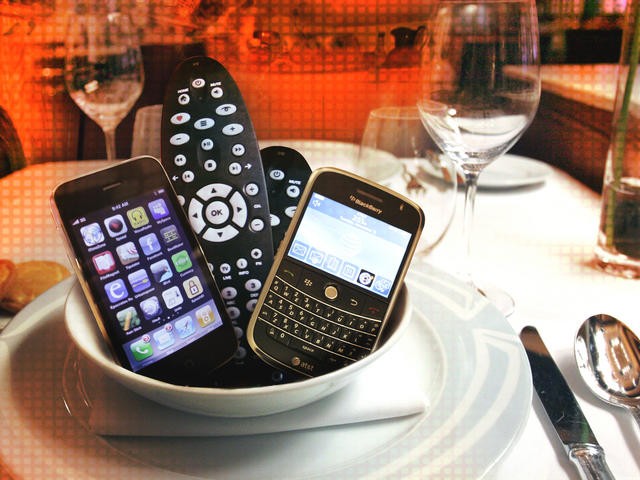In 21st century America, when we no longer quilt on the front porch, play musical instruments together, or plant beans side by side in the field, dinner is often the primary occasion we use to connect with one another. It’s also an important time to tell family stories, teach social skills, and model good manners. There can be so much going on at dinner, it’s a wonder there’s time to eat!
Teaching manners at the table used to be a fairly straightforward, top-down parenting activity. Parents told their kids not to talk with their mouths full, to keep elbows off the table, and to stay seated until everyone had finished eating. Parents knew the rules and imparted them. But today’s parents have a whole new set of table manners to grapple with—those associated with technology. And, according to our survey data, this is a dicey area, where what’s good for the gosling turns out not to be so good for the goose.
Many parents have two sets of standards for technology rules at the table. According to our Digital Family survey responses of over 300 parents, only 18% of them allow their children to use technology at the dinner table, while almost twice that number of parents believe that is OK for them to use their phones and screens at the table.
The table manners that really matter are the ones that help us connect with one another at the table. That’s why reprimanding kids to keep their elbows off the table seems much less important than insisting on no interrupting when someone is speaking. If we look at the use of technology through this lens perhaps there is some nuanced advice to offer:
- Use tech to spark talk, not to shut it down—When technology at the table competes with conversation or makes us feel that we don’t have the full attention when we speak, technology has no place at the table. But, what about the times that technology enhances connection? ‘Hey, look at this photo from class today?’ Or, ‘I want to read you a funny text I got from your aunt’. In other words, if technology can be shared at the table, perhaps it has a place. Maybe just a small place.
- Model tech etiquette—Do as I say, and do as I do. In other words try to model the same technology manners that you expect your children to follow.
- Set tech rules with your family—As a family, decide on the rules for technology use at the table. Perhaps, everyone can check their smart phones at the door or put them in a cabinet or in a basket. Or instead, your family may decide to reserve the right to use search functions to settle disputes that arise at the table.
- Prevent temptation: silence devices—If you follow a ‘no technology’ policy, agree to keep digital devices on silent mode and out of the kitchen during mealtime. It’s going to be hard for a teen to resist checking if a beep or a ding indicates that a message has just come in. But if you all agree on the policy, you should stick to it.
- Transition from tech time to dinnertime—Giving kids a 5-minute warning before dinner is helpful in smoothing the transition from tech time to dinnertime. Some kids may need even longer to disengage from their screens.
- Get connected (with your family)—Let technology work with your goals of having more and better family dinners: Download our new “Food, Fun and Conversation: 4 Weeks to Better Family Dinners.”
As in many areas of modern life, our use of technology far outstrips our scientific understanding of it. There may be some good reasons to use tech at the table. Some might argue that playing a video game at the table could encourage conversations or that being able to share an interesting email could vividly bring your family up to speed on a conflict you’re having with a colleague. Maybe, when adolescents are allowed to use technology at the table, they are more likely to share doubts they have about what they are sharing on Facebook. What about the benefits of Skyping during a meal with grandparents who live across the country?
However, we can’t ignore the possible downsides either. Several studies have shown that TV-watching during dinner is associated with greater caloric intake and lower consumption of eating fruits and vegetables. Other distractions during mealtime like playing computer games or being away from the table are also associated with disruptions in family interaction. We don’t have enough data yet to answer the question of how the impact of small screens plays out at the table, but there is no substitute for the connections that come from the face-to-face interactions of sharing a family meal.
This piece was written by Anne Fishel, PhD, and Tristan Gorrindo, MD, who is managing director of The Clay Center for Young Healthy Minds. He is also a child and adolescent psychiatrist at Massachusetts General Hospital.

